More than XRF Mapping: STEAM (Statistically Tailored Elemental Angle Mapper) a Pioneering Analysis Protocol for Pigment Studies †
Abstract
1. Introduction
1.1. State of the Art Instruments and Methods
1.2. State of the Art. Data Handling and Synergic Applications
2. Materials and Methods
2.1. Instrumentation
2.1.1. ELIO Spectrometer by XGLab Srl
2.1.2. ARTAX 200 Spectrometer by Bruker
2.2. Data Handling and Samples
2.2.1. The MA-XRF Database
2.2.2. The Reference Panel
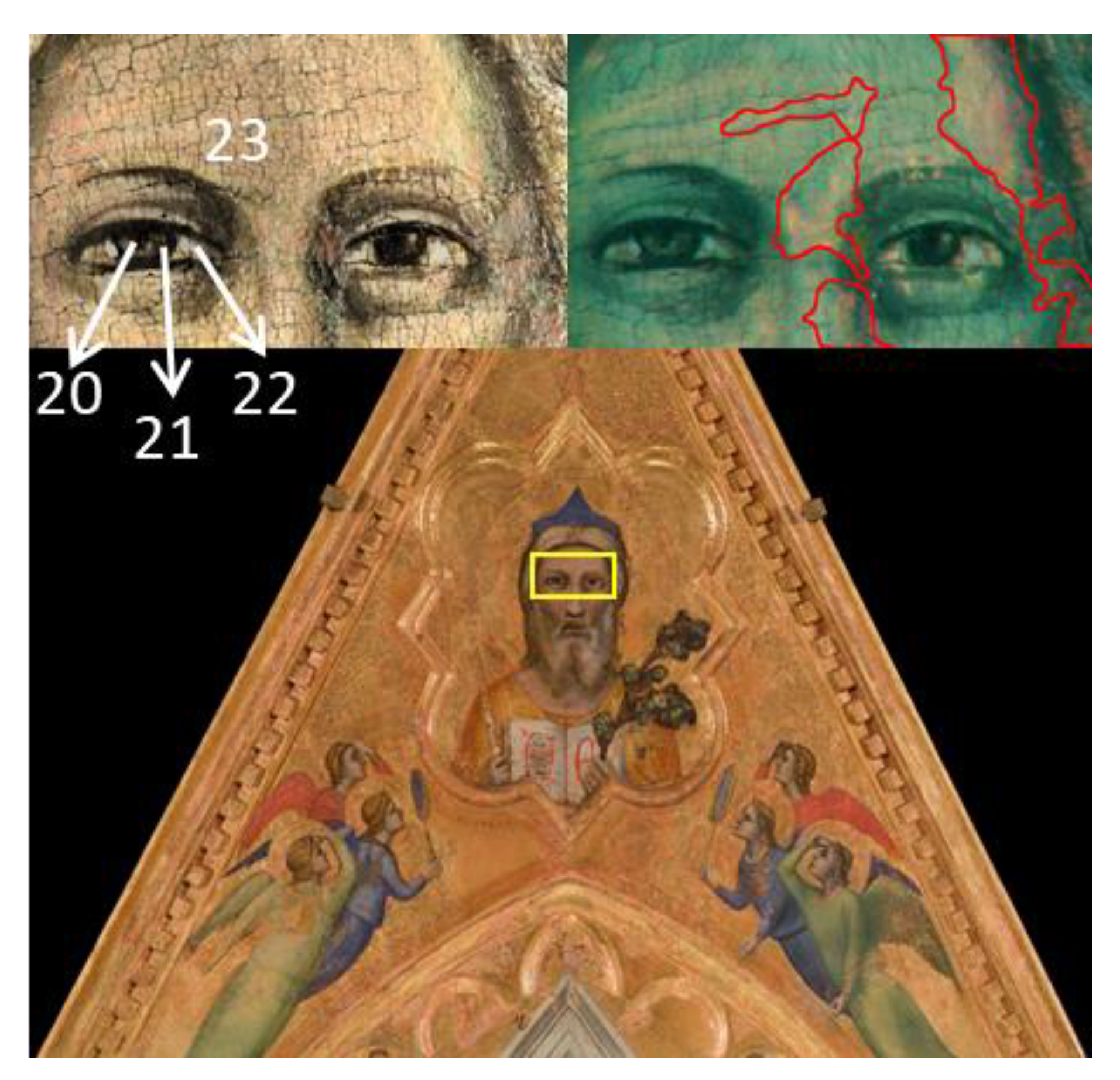
2.2.3. Punctual XRF Test Set
| Right Angels Green dress (1) | Right Angels Blue dress (2) | Right Angels Face of the green dressed (3) | Right Angels Hair of the green dressed (4) | Right Angels Halo of the green dressed (5) |
| Right Angels Sleeve of the green dressed (6) | Right Angels Red dress (7) | Right Angels Hair of the blue dressed (8) | Left Angels Green dress (9) | Left Angels Blue dress (10) |
| Left Angels Sleeve of the bleu dressed (11) | Left Angels Red dress (12) | Left Angels Face of the red dressed (13) | Book Black Ink (14) | Book White of the pages (15) |
| Book Red ink (16) | God the Father Yellow dress (17) | God the Father Blue hat I (18) | God the Father Blue hat II (19) | God the Father Pupil (20) |
| God the father Iris (21) | God the Father Sclera (22) | God the Father Face (23) |
2.3. The STEAM Protocol
2.3.1. STEAM vs. SAMs
2.3.2. STEAM and GS
3. Results
3.1. Characterization of the Reference Panel
3.2. Characterization of the Punctual XRF Test Set from the Gable “God the Father with Angels”
4. Discussion
5. Conclusions
Author Contributions
Funding
Institutional Review Board Statement
Informed Consent Statement
Acknowledgments
Conflicts of Interest
References
- Tsuji, K.; Nakano, K.; Hayashi, H.; Hayashi, K.; Ro, C.-U. X-Ray Spectrometry. Anal. Chem. 2008, 80, 4421–4454. [Google Scholar] [CrossRef] [PubMed]
- Romano, F.P.; Pappalardo, L.; Biondi, G.; Caliri, C.; Masini, N.; Rizzo, F.; Santos, H.C. FF-XRF, XRD, and PIXE for the Nondestructive Investigation of Archaeological Pigments. In Sensing the Past: From Artifact to Historical Site; Masini, N., Soldovieri, F., Eds.; Geotechnologies and the Environment; Springer International Publishing: Cham, Switzerland, 2017; pp. 325–336. ISBN 978-3-319-50518-3. [Google Scholar]
- Romano, F.P.; Caliri, C.; Cosentino, L.; Gammino, S.; Giuntini, L.; Mascali, D.; Neri, L.; Pappalardo, L.; Rizzo, F.; Taccetti, F. Macro and Micro Full Field X-Ray Fluorescence with an X-Ray Pinhole Camera Presenting High Energy and High Spatial Resolution. Anal. Chem. 2014, 86, 10892–10899. [Google Scholar] [CrossRef] [PubMed]
- Walter, P.; Sarrazin, P.; Gailhanou, M.; Hérouard, D.; Verney, A.; Blake, D. Full-field XRF Instrument for Cultural Heritage: Application to the Study of a Caillebotte Painting. X Ray Spectrom. 2019, 48, 274–281. [Google Scholar] [CrossRef]
- Stromberg, J.M.; Van Loon, L.L.; Gordon, R.; Woll, A.; Feng, R.; Schumann, D.; Banerjee, N.R. Applications of Synchrotron X-Ray Techniques to Orogenic Gold Studies; Examples from the Timmins Gold Camp. Ore Geol. Rev. 2019, 104, 589–602. [Google Scholar] [CrossRef]
- Pan, Y.; Hu, L.; Zhao, T. Applications of Chemical Imaging Techniques in Paleontology. Natl. Sci. Rev. 2019, 6, 1040–1053. [Google Scholar] [CrossRef]
- Li, J.; Pei, R.; Teng, F.; Qiu, H.; Tagle, R.; Yan, Q.; Wang, Q.; Chu, X.; Xu, X. Micro-XRF Study of the Troodontid Dinosaur Jianianhualong Tengi Reveals New Biological and Taphonomical Signals. bioRxiv 2020. [Google Scholar] [CrossRef]
- Langstraat, K.; Knijnenberg, A.; Edelman, G.; van de Merwe, L.; van Loon, A.; Dik, J.; van Asten, A. Large Area Imaging of Forensic Evidence with MA-XRF. Sci. Rep. 2017, 7, 15056. [Google Scholar] [CrossRef]
- Yan, J.; Chia, J.-C.; Sheng, H.; Jung, H.; Zavodna, T.-O.; Zhang, L.; Huang, R.; Jiao, C.; Craft, E.J.; Fei, Z.; et al. Arabidopsis Pollen Fertility Requires the Transcription Factors CITF1 and SPL7 That Regulate Copper Delivery to Anthers and Jasmonic Acid Synthesis. Plant Cell 2017, 29, 3012–3029. [Google Scholar] [CrossRef]
- Lider, V.V. X-Ray Fluorescence Imaging. Phys. Usp. 2018, 61, 980. [Google Scholar] [CrossRef]
- Romano, F.P.; Janssens, K. Preface to the Special Issue on: MA-XRF “Developments and Applications of Macro-XRF in Conservation, Art, and Archeology” (Trieste, Italy, 24 and 25 September 2017). X Ray Spectrom. 2019, 48, 249–250. [Google Scholar] [CrossRef]
- Special Issue: First Workshop on Macro X-Ray Flourescence (MA-ARF) Scanning, 24 September 2017, Trieste, Italy. X Ray Spectrom. 2017, 48, 247–318. [CrossRef]
- Alfeld, M.; Gonzalez, V.; van Loon, A. Data Intrinsic Correction for Working Distance Variations in MA-XRF of Historical Paintings Based on the Ar Signal. X Ray Spectrom. 2020. [Google Scholar] [CrossRef]
- Cavaleri, T.; Buscaglia, P.; Caliri, C.; Ferraris, E.; Nervo, M.; Romano, F.P. Below the Surface of the Coffin Lid of Neskhonsuennekhy in the Museo Egizio Collection. X Ray Spectrom. 2020. [Google Scholar] [CrossRef]
- Gargano, M.; Galli, A.; Bonizzoni, L.; Alberti, R.; Aresi, N.; Caccia, M.; Castiglioni, I.; Interlenghi, M.; Salvatore, C.; Ludwig, N.; et al. The Giotto’s Workshop in the XXI Century: Looking inside the “God the Father with Angels” Gable. J. Cult. Herit. 2019, 36, 255–263. [Google Scholar] [CrossRef]
- Alfeld, M.; Mulliez, M.; Devogelaere, J.; de Viguerie, L.; Jockey, P.; Walter, P. MA-XRF and Hyperspectral Reflectance Imaging for Visualizing Traces of Antique Polychromy on the Frieze of the Siphnian Treasury. Microchem. J. 2018, 141, 395–403. [Google Scholar] [CrossRef]
- Uhlir, K.; Gironda, M.; Bombelli, L.; Eder, M.; Aresi, N.; Groschner, G.; Griesser, M. Rembrandt’s Old Woman Praying, 1629/30: A Look below the Surface Using X-ray Fluorescence Mapping. X Ray Spectrom. 2019, 48, 293–302. [Google Scholar] [CrossRef]
- D’Elia, E.; Buscaglia, P.; Piccirillo, A.; Picollo, M.; Casini, A.; Cucci, C.; Stefani, L.; Romano, F.P.; Caliri, C.; Gulmini, M. Macro X-Ray Fluorescence and VNIR Hyperspectral Imaging in the Investigation of Two Panels by Marco d’Oggiono. Microchem. J. 2020, 154, 104541. [Google Scholar] [CrossRef]
- dos Santos, H.C.; Caliri, C.; Pappalardo, L.; Catalano, R.; Orlando, A.; Rizzo, F.; Romano, F.P. Real-Time MA-XRF Imaging Spectroscopy of the Virgin with the Child Painted by Antonello de Saliba in 1497. Microchem. J. 2018, 140, 96–104. [Google Scholar] [CrossRef]
- Alfeld, M.; Pedetti, S.; Martinez, P.; Walter, P. Joint Data Treatment for Vis–NIR Reflectance Imaging Spectroscopy and XRF Imaging Acquired in the Theban Necropolis in Egypt by Data Fusion and t-SNE. Comptes Rendus Phys. 2018, 19, 625–635. [Google Scholar] [CrossRef]
- Galli, A.; Gargano, M.; Bonizzoni, L.; Bruni, S.; Interlenghi, M.; Longoni, M.; Passaretti, A.; Caccia, M.; Salvatore, C.; Castiglioni, I.; et al. Imaging and Spectroscopic Data Combined to Disclose the Painting Techniques and Materials in the Fifteenth Century Leonardo Atelier in Milan. Dye. Pigment. 2021, 187, 109112. [Google Scholar] [CrossRef]
- Alfeld, M.; Janssens, K.; Dik, J.; de Nolf, W.; van der Snickt, G. Optimization of Mobile Scanning Macro-XRF Systems for the in Situ Investigation of Historical Paintings. J. Anal. At. Spectrom. 2011, 26, 899–909. [Google Scholar] [CrossRef]
- Alfeld, M.; Janssens, K. Strategies for Processing Mega-Pixel X-Ray Fluorescence Hyperspectral Data: A Case Study on a Version of Caravaggio’s Painting Supper at Emmaus. J. Anal. At. Spectrom. 2015, 30, 777–789. [Google Scholar] [CrossRef]
- Romano, F.P.; Caliri, C.; Nicotra, P.; Di Martino, S.; Pappalardo, L.; Rizzo, F.; Santos, H.C. Real-Time Elemental Imaging of Large Dimension Paintings with a Novel Mobile Macro X-Ray Fluorescence (MA-XRF) Scanning Technique. J. Anal. At. Spectrom. 2017, 32, 773–781. [Google Scholar] [CrossRef]
- Alfeld, M.; Nolf, W.D.; Cagno, S.; Appel, K.; Siddons, D.P.; Kuczewski, A.; Janssens, K.; Dik, J.; Trentelman, K.; Walton, M.; et al. Revealing Hidden Paint Layers in Oil Paintings by Means of Scanning Macro-XRF: A Mock-up Study Based on Rembrandt’s “An Old Man in Military Costume”. J. Anal. At. Spectrom. 2012, 28, 40–51. [Google Scholar] [CrossRef]
- Kogou, S.; Lee, L.; Shahtahmassebi, G.; Liang, H. A New Approach to the Interpretation of XRF Spectral Imaging Data Using Neural Networks. X Ray Spectrom. 2020. [Google Scholar] [CrossRef]
- Mantler, M.; Schreiner, M.; Weber, F.; Ebner, R.; Mairinger, F. An X-Ray Spectrometer for Pixel Analysis of Art Objects. Adv. X Ray Anal. 1991, 35, 987–993. [Google Scholar] [CrossRef]
- Alfeld, M.; de Viguerie, L. Recent Developments in Spectroscopic Imaging Techniques for Historical Paintings—A Review. Spectrochim. Acta Part B At. Spectrosc. 2017, 136, 81–105. [Google Scholar] [CrossRef]
- Alberti, R.; Frizzi, T.; Bombelli, L.; Gironda, M.; Aresi, N.; Rosi, F.; Miliani, C.; Tranquilli, G.; Talarico, F.; Cartechini, L. CRONO: A Fast and Reconfigurable Macro X-Ray Fluorescence Scanner for in-Situ Investigations of Polychrome Surfaces. X Ray Spectrom. 2017, 46, 297–302. [Google Scholar] [CrossRef]
- Ravaud, E.; Pichon, L.; Laval, E.; Gonzalez, V.; Eveno, M.; Calligaro, T. Development of a Versatile XRF Scanner for the Elemental Imaging of Paintworks. Appl. Phys. A 2015, 122, 17. [Google Scholar] [CrossRef]
- Pouyet, E.; Barbi, N.; Chopp, H.; Healy, O.; Katsaggelos, A.; Moak, S.; Mott, R.; Vermeulen, M.; Walton, M. Development of a Highly Mobile and Versatile Large MA-XRF Scanner for in Situ Analyses of Painted Work of Arts. X Ray Spectrom. 2020. [Google Scholar] [CrossRef]
- Van der Snickt, G.; Dubois, H.; Sanyova, J.; Legrand, S.; Coudray, A.; Glaude, C.; Postec, M.; Van Espen, P.; Janssens, K. Large-Area Elemental Imaging Reveals Van Eyck’s Original Paint Layers on the Ghent Altarpiece (1432), Rescoping Its Conservation Treatment. Angew. Chem. 2017, 129, 4875–4879. [Google Scholar] [CrossRef]
- Mazzinghi, A.; Ruberto, C.; Castelli, L.; Ricciardi, P.; Czelusniak, C.; Giuntini, L.; Mandò, P.A.; Manetti, M.; Palla, L.; Taccetti, F. The Importance of Being Little: MA-XRF on Manuscripts on a Venetian Island. X Ray Spectrom. 2020. [Google Scholar] [CrossRef]
- Kogou, S.; Lucian, A.; Bellesia, S.; Burgio, L.; Bailey, K.; Brooks, C.; Liang, H. A Holistic Multimodal Approach to the Non-Invasive Analysis of Watercolour Paintings. Appl. Phys. A 2015, 121, 999–1014. [Google Scholar] [CrossRef]
- Ricciardi, P.; Legrand, S.; Bertolotti, G.; Janssens, K. Macro X-Ray Fluorescence (MA-XRF) Scanning of Illuminated Manuscript Fragments: Potentialities and Challenges. Microchem. J. 2016, 124, 785–791. [Google Scholar] [CrossRef]
- Duivenvoorden, J.R.; Käyhkö, A.; Kwakkel, E.; Dik, J. Hidden Library: Visualizing Fragments of Medieval Manuscripts in Early-Modern Bookbindings with Mobile Macro-XRF Scanner. Herit. Sci. 2017, 5, 6. [Google Scholar] [CrossRef]
- Alfeld, M.; Baraldi, C.; Gamberini, M.C.; Walter, P. Investigation of the Pigment Use in the Tomb of the Reliefs and Other Tombs in the Etruscan Banditaccia Necropolis. X Ray Spectrom. 2019, 48, 262–273. [Google Scholar] [CrossRef]
- Kozachuk, M.S.; Sham, T.-K.; Martin, R.R.; Nelson, A.J.; Coulthard, I.; McElhone, J.P. Recovery of Degraded-Beyond-Recognition 19th Century Daguerreotypes with Rapid High Dynamic Range Elemental X-Ray Fluorescence Imaging of Mercury L Emission. Sci. Rep. 2018, 8, 9565. [Google Scholar] [CrossRef] [PubMed]
- Bonizzoni, L.; Maloni, A.; Milazzo, M. Evaluation of Effects of Irregular Shape on Quantitative XRF Analysis of Metal Objects. X Ray Spectrom. 2006, 35, 390–399. [Google Scholar] [CrossRef]
- Brunetti, A.; Golosio, B. A New Monte Carlo Code for Simulation of the Effect of Irregular Surfaces on X-Ray Spectra. Spectrochim. Acta Part B At. Spectrosc. 2014, 94–95, 58–62. [Google Scholar] [CrossRef]
- Trojek, T. Reduction of Surface Effects and Relief Reconstruction in X-Ray Fluorescence Microanalysis of Metallic Objects. J. Anal. At. Spectrom. 2011, 26, 1253–1257. [Google Scholar] [CrossRef]
- Saleh, M.; Bonizzoni, L.; Orsilli, J.; Samela, S.; Gargano, M.; Gallo, S.; Galli, A. Application of Statistical Analyses for Lapis Lazuli Stone Provenance Determination by XRL and XRF. Microchem. J. 2020, 154, 104655. [Google Scholar] [CrossRef]
- Weyermann, J.; Schläpfer, D.; Hueni, A.; Kneubühler, M.; Schaepman, M. Spectral Angle Mapper (SAM) for Anisotropy Class Indexing in Imaging Spectrometry Data; Shen, S.S., Lewis, P.E., Eds.; International Society for Optics and Photonics: San Diego, CA, USA, 2009; p. 74570B. [Google Scholar]
- Panchuk, V.; Yaroshenko, I.; Legin, A.; Semenov, V.; Kirsanov, D. Application of Chemometric Methods to XRF-Data—A Tutorial Review. Anal. Chim. Acta 2018, 1040, 19–32. [Google Scholar] [CrossRef] [PubMed]
- Leardi, R. (Ed.) Nature-Inspired Methods in Chemometrics: Genetic Algorithms and Artificial Neural Networks, Data Handling in Science and Technology, 1st ed.; Elsevier Science: Amsterdam, The Netherlands, 2003; Volume 23, ISBN 978-0-444-51350-2. [Google Scholar]
- Galli, A.; Caccia, M.; Alberti, R.; Bonizzoni, L.; Aresi, N.; Frizzi, T.; Bombelli, L.; Gironda, M.; Martini, M. Discovering the Material Palette of the Artist: A p-XRF Stratigraphic Study of the Giotto Panel ‘God the Father with Angels’: Discovering the Pigment Palette Using a p-XRF Stratigraphic Analysis. X Ray Spectrom. 2017, 46, 435–441. [Google Scholar] [CrossRef]
- Ciatti, M.; Seidel, M. (Eds.) Giotto. La Croce di Santa Maria Novella; Problemi di Conservazione e Restauro; EDIFIR: Firenze, Italy, 2003; ISBN 88-7970-106-1. [Google Scholar]
- Romano, S.; Petraroia, P. Giotto, l’Italia. Catalogo della Mostra; Illustrated Edizione; Mondadori Electa: Milano, Italy, 2015; ISBN 978-88-918-0513-3. [Google Scholar]
- Bonizzoni, L.; Galli, A.; Poldi, G. In Situ EDXRF Analyses on Renaissance Plaquettes and Indoor Bronzes Patina Problems and Provenance Clues. X Ray Spectrom. 2008, 37, 388–394. [Google Scholar] [CrossRef]
- Barcellos Lins, S.A.; Ridolfi, S.; Gigante, G.E.; Cesareo, R.; Albini, M.; Riccucci, C.; di Carlo, G.; Fabbri, A.; Branchini, P.; Tortora, L. Differential X-Ray Attenuation in MA-XRF Analysis for a Non-Invasive Determination of Gilding Thickness. Front. Chem. 2020, 8, 175. [Google Scholar] [CrossRef]
- Saverwyns, S.; Currie, C.; Lamas-Delgado, E. Macro X-Ray Fluorescence Scanning (MA-XRF) as Tool in the Authentication of Paintings. Microchem. J. 2018, 137, 139–147. [Google Scholar] [CrossRef]
- Schowengerdt, R. Remote Sensing; Models and Methods for Image Processing, 3rd ed.; Elsevier: Amsterdam, The Netherlands, 2006; ISBN 978-0-12-369407-2. [Google Scholar]
- Daniel, F.; Mounier, A.; Pérez-Arantegui, J.; Pardos, C.; Prieto-Taboada, N.; de Vallejuelo, S.F.O.; Castro, K. Hyperspectral Imaging Applied to the Analysis of Goya Paintings in the Museum of Zaragoza (Spain). Microchem. J. 2016, 126, 113–120. [Google Scholar] [CrossRef]
- Kruse, F.A.; Richardson, L.L.; Ambrosia, V.G. Techniques Developed for Geologic Analysis of Hyperspectral Data Applied to Near-Shore Hyperspectral Ocean Data. In Proceedings of the ERIM 4th International Conference, Remote Sensing for Marine and Coastal Environments: Environmental Research Institute of Michigan (ERIM), Ann Arbor, MI, USA, 17–19 March 1997; Volume I, pp. I-233–I-246. [Google Scholar]
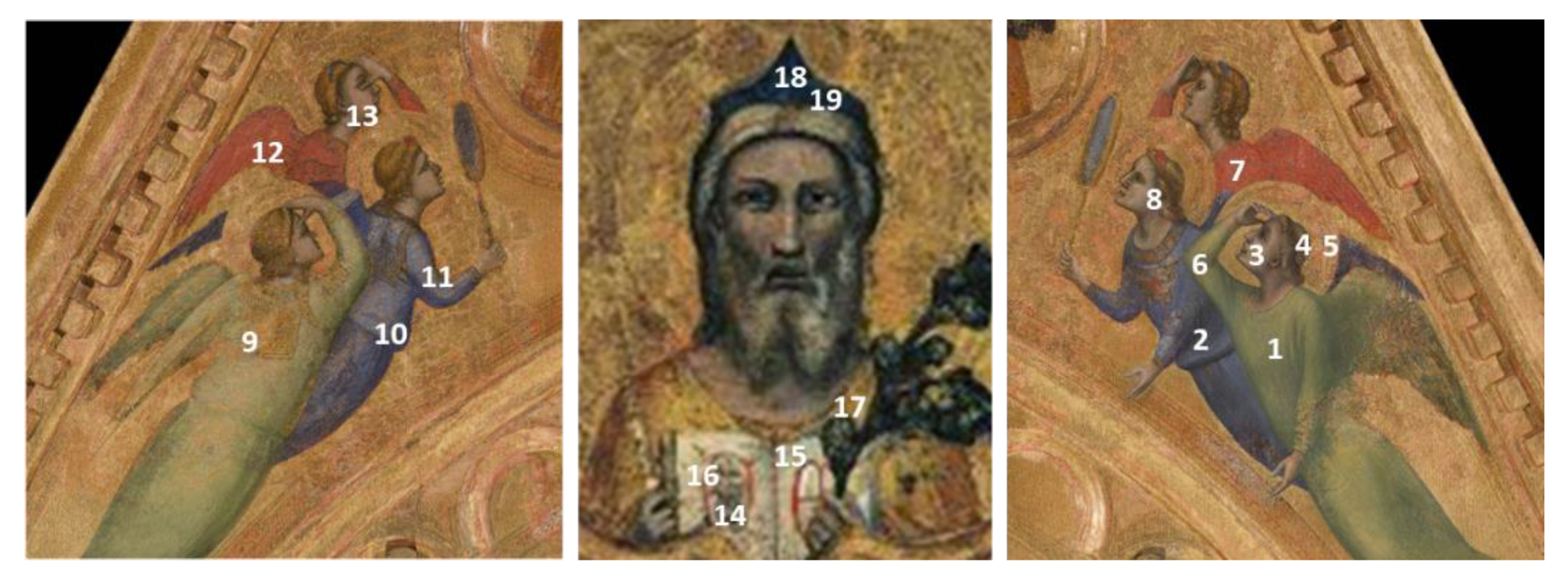
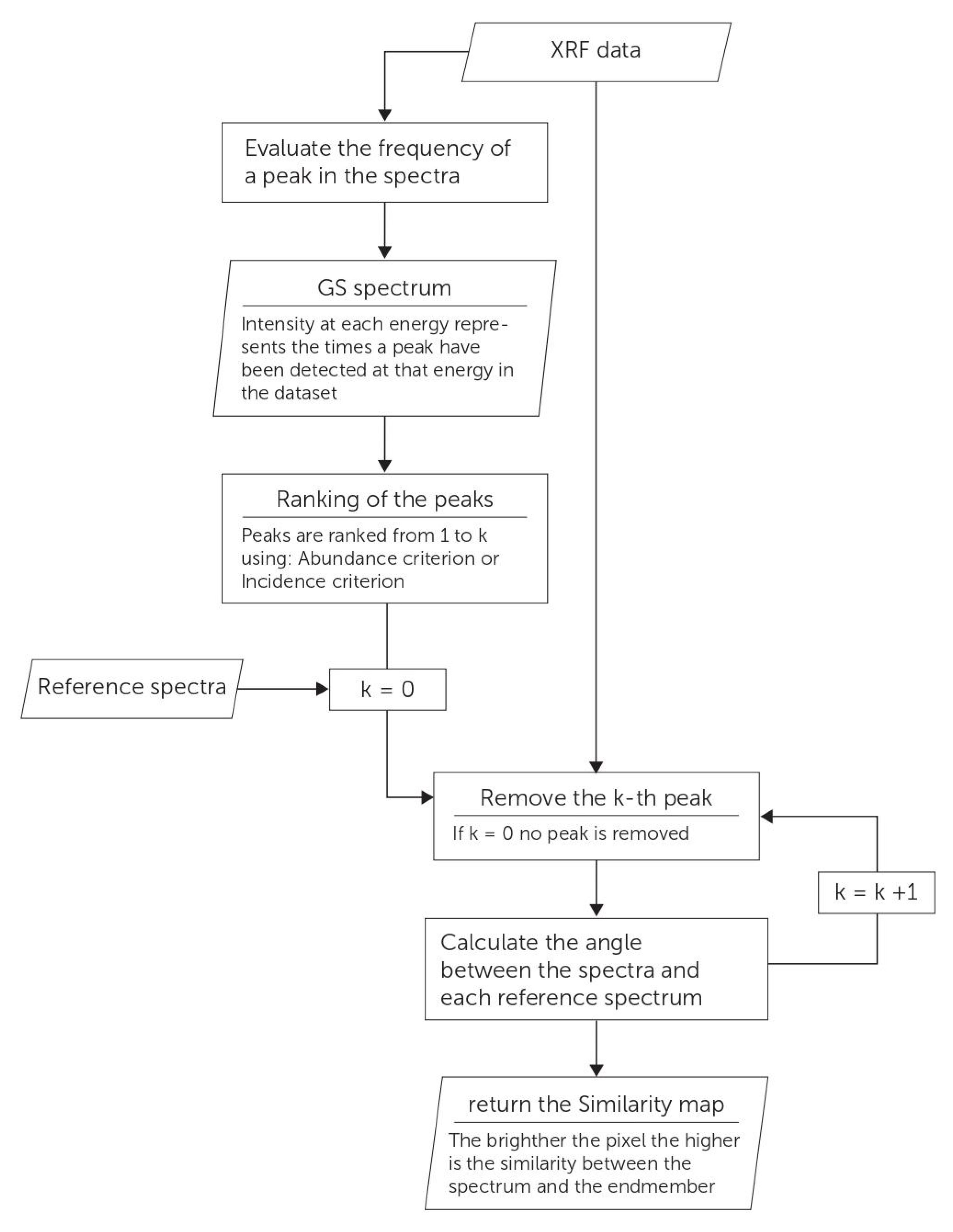
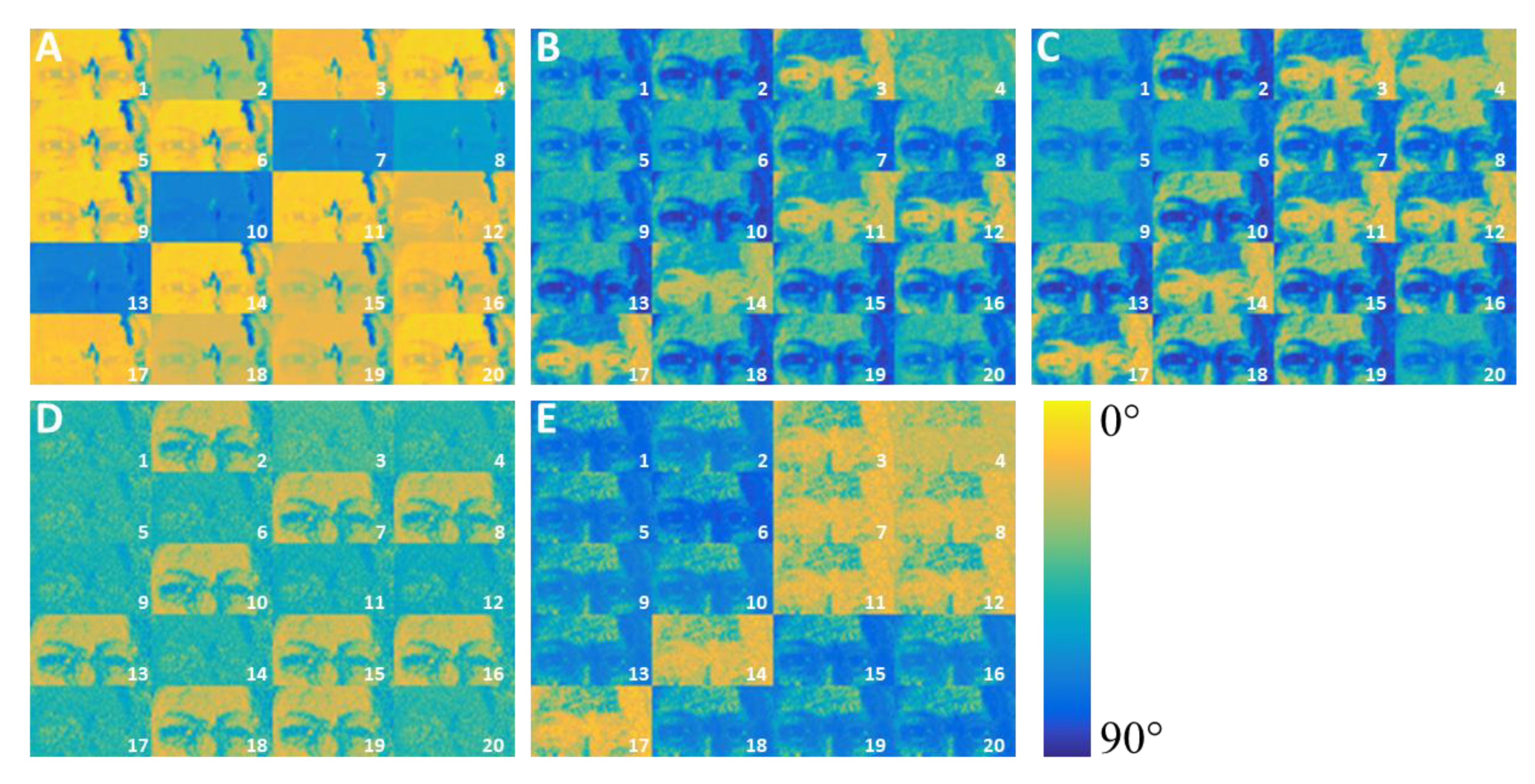


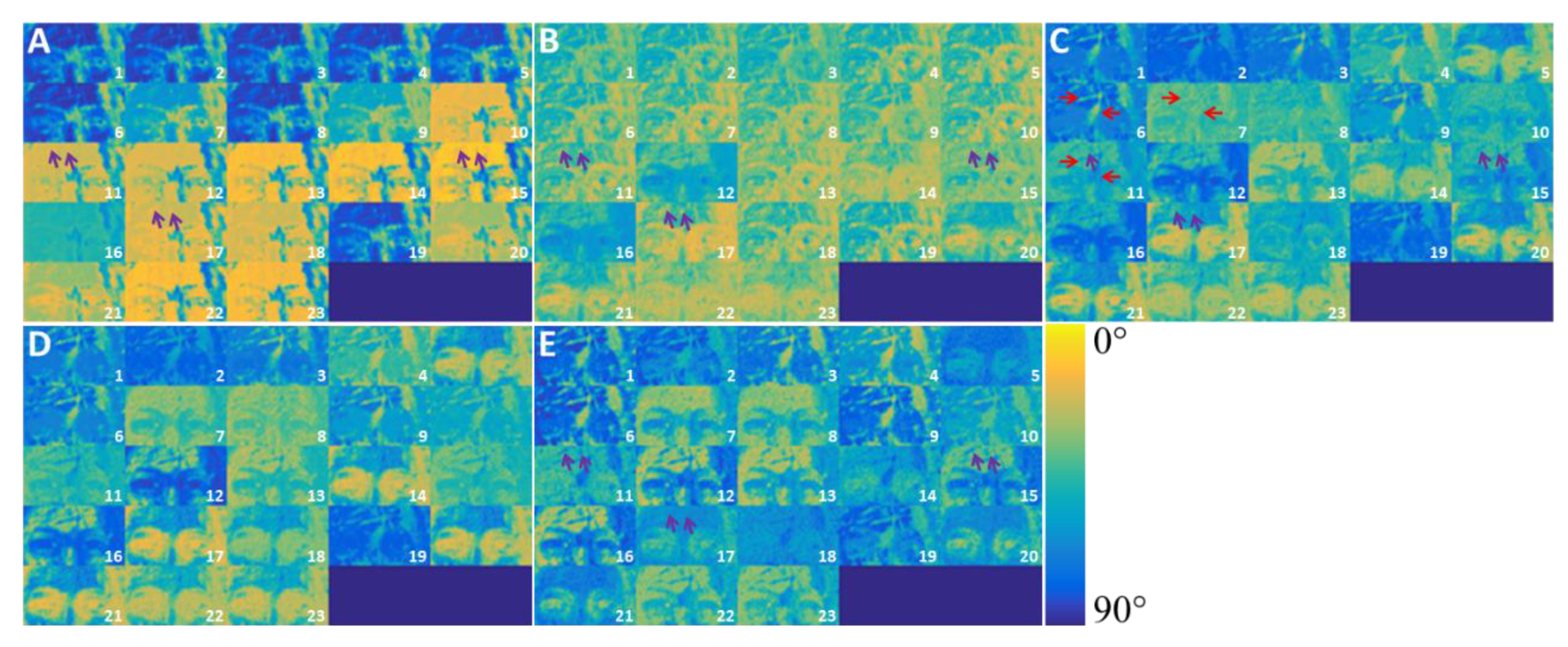
|
|
|
|
|
|
|
|
|
|
|
|
|
|
|
|
|
|
|
|
| Panel | A | B | C | D | ||||||
|---|---|---|---|---|---|---|---|---|---|---|
| Ranking (q) | 0 | 1 | 2 | 3 | 4 | 5 | 6 | 7 | 8 | 9 |
| Energy (keV) | 10.5 | 12.6 | 9.2 | 13.8 | 8.8 | 6.4 | 11.8 | 10.0 | 11.3 | |
| X-ray transition | Lα (Pb) | Lβ (Pb) | LI (Pb) | Lγ (Hg) | LI (Hg) | Kα (Fe) | Lβ (Hg) | Lα (Hg) | Lη (Pb) |
| Panel | A | B | C | |||||||
|---|---|---|---|---|---|---|---|---|---|---|
| Ranking (q) | 0 | 1 | 2 | 3 | 4 | 5 | 6 | 7 | 8 | 9 |
| Energy (keV) | 10.5 | 12.6 | 11.8 | 10 | 6.4 | 9.2 | 11.3 | 13.8 | 8.8 | |
| X-ray transition | Lα (Pb) | Lβ (Pb) | Lβ (Hg) | Lα (Hg) | Kα (Fe) | LI (Pb) | Lη (Pb) | Lγ (Hg) | LI (Hg) |
| Panel | A | B | C | D | E | F | G | H | I | |||||
|---|---|---|---|---|---|---|---|---|---|---|---|---|---|---|
| Ranking (q) | 0 | 1 | 2 | 3 | 4 | 5 | 6 | 7 | 8 | 9 | 10 | 11 | 12 | 13 |
| Energy (keV) | 10.5 | 4 | 14.1 | 3.6 | 6.4 | 12.6 | 4.5 | 10 | 3.3 | 7 | 4.9 | 9.1 | 6.9 | |
| X-ray transition | Lα (Pb) | Kβ (Ca) | Kα (Sr) | Kα (Ca) | Kα (Fe) | Lβ (Pb) | Kα (Ti) | Lα (Hg) | Kα (K) | Kβ (Fe) | Kβ (Ti) | LI (Pb) | Kα (Co) |
| Panel | A | B | C | D | E | |||||||||
|---|---|---|---|---|---|---|---|---|---|---|---|---|---|---|
| Ranking (q) | 0 | 1 | 2 | 3 | 4 | 5 | 6 | 7 | 8 | 9 | 10 | 11 | 12 | 13 |
| Energy (keV) | 10.5 | 12.6 | 4 | 3.6 | 9.1 | 14.1 | 3.3 | 6.4 | 7 | 4.8 | 4.4 | 10 | 6.9 | |
| X-ray transition | Lα (Pb) | Lβ (Pb) | Kβ (Ca) | Kα (Ca) | LI (Pb) | Kα (Sr) | Kα (K) | Kα (Fe) | Kβ (Fe) | Kβ (Ti) | Kα (Ti) | Lα (Hg) | Kα (Co) |
Publisher’s Note: MDPI stays neutral with regard to jurisdictional claims in published maps and institutional affiliations. |
© 2021 by the authors. Licensee MDPI, Basel, Switzerland. This article is an open access article distributed under the terms and conditions of the Creative Commons Attribution (CC BY) license (http://creativecommons.org/licenses/by/4.0/).
Share and Cite
Orsilli, J.; Galli, A.; Bonizzoni, L.; Caccia, M. More than XRF Mapping: STEAM (Statistically Tailored Elemental Angle Mapper) a Pioneering Analysis Protocol for Pigment Studies. Appl. Sci. 2021, 11, 1446. https://doi.org/10.3390/app11041446
Orsilli J, Galli A, Bonizzoni L, Caccia M. More than XRF Mapping: STEAM (Statistically Tailored Elemental Angle Mapper) a Pioneering Analysis Protocol for Pigment Studies. Applied Sciences. 2021; 11(4):1446. https://doi.org/10.3390/app11041446
Chicago/Turabian StyleOrsilli, Jacopo, Anna Galli, Letizia Bonizzoni, and Michele Caccia. 2021. "More than XRF Mapping: STEAM (Statistically Tailored Elemental Angle Mapper) a Pioneering Analysis Protocol for Pigment Studies" Applied Sciences 11, no. 4: 1446. https://doi.org/10.3390/app11041446
APA StyleOrsilli, J., Galli, A., Bonizzoni, L., & Caccia, M. (2021). More than XRF Mapping: STEAM (Statistically Tailored Elemental Angle Mapper) a Pioneering Analysis Protocol for Pigment Studies. Applied Sciences, 11(4), 1446. https://doi.org/10.3390/app11041446








